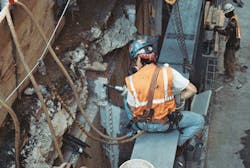Mr. President: Help Worker Safety by Updating Obsolete OSHA Regulations
On the campaign trail, President Barack Obama discussed the importance of helping boost the economy by easing regulatory burdens on companies where appropriate. OSHA certainly has been aggressive during the president's first term, dramatically increasing enforcement, and it might seem a logical first step to change tactics there. I continue to believe that ramped-up enforcement, by what was dubbed as the “new" OSHA, is misguided and ineffective.
But there is another second-term initiative that might be more successful in protecting workers while helping businesses: bringing outdated OSHA regulations into the 21st century.
Many of OSHA's standards haven't been changed since President Richard Nixon signed the agency into law in December 1970. Then, an estimated 14,000 workers were killed on the job each year, about 38 workers every day. While U.S. employment has tripled in the years since, the number of deaths has dropped by more than two-thirds to 12 workers per day, according to the Bureau of Labor Statistics.
Subscribe to EHS Today Magazine to receive leading coverage of the EHS industry.
The number of serious workplace injuries also has dropped significantly since 1970, from 11 per 100 workers in 1972 to 3.5 per 100 workers in 2010, the most recent year for which statistics are available.
It might seem logical, then, to look at those lowered injury rates as an unmitigated success story.
But serious worker accidents actually reached a plateau during the last few years of the Bush administration. President Obama's tougher stance hasn't worked and it's been a burden on businesses, already struggling in a challenging economy. Preliminary figures show that 2011 on-the-job fatalities are higher than in 2009, though slightly below the number for 2010.
A critical barrier to further progress can be found in OSHA regulations themselves, some of which haven't been updated since the Nixon administration. It's not hard to find references to equipment that no longer is used, and procedures that are no longer relevant. So if a second Obama administration indeed brings a new approach, I would recommend a focus on updating OSHA regulations. I believe this will resume the downward trend in injuries and illnesses.
A Look at Employee Falls
So why do outdated OSHA regulations matter? Can't a company just embrace the portions that are still in practice while ignoring those that are not? Sure, but the end result likely will be confused employers utilizing safety practices that may not be the most effective, or in the best interest of the workers.
Workers and employers must work together to create a safe work environment. To do so, they both clearly must understand what is expected of them. If that were the case, serious injuries and illnesses very likely would drop.
Nowhere is this more evident than in fall protection. Falls remain one of the most common causes of on-the-job fatalities, ranking behind traffic accidents and workplace violence, according to the Bureau of Labor Statistics. In 2010, 14 percent of all workplace fatalities were due to falls.
This broad category includes falls from ladders (20 percent), from roofs (18 percent) and from the same level (15 percent). Other types of falls include those from non-moving vehicles, down stairs or steps, from structural steel or from ground level.
Yet fall protection general industry standards haven't been revised for decades. They fail to mention safety harnesses or lanyards, which are common types of personal protective equipment that are in use in general industry. The general industry fall protection regulations also fail to address working on elevated surfaces that are not floors, platforms or runways. As anyone who has worked in safety knows, elevated surfaces encompass far more than these three types of walking/working surfaces.
Drilling Down to Falls from Nonmoving Vehicles
We can hone in a bit more on falls from non-moving vehicles as just one example of outdated and incomplete regulations. In general industry, OSHA has no specific regulations covering fall protection on vehicles (rolling stock).
The initial general industry fall protection proposed standard explicitly excluded vehicles from coverage. While this standard was not promulgated, it does show the gaps in OSHA's general industry fall protection standard.
It's not the only one. OSHA typically has failed to cite falls from rolling stock under Subpart D of 1910. OSHA also has determined that it is not appropriate to use the personal protection equipment standard, 1910.132, unless the vehicle is positioned inside or next to a building or other structure where it would be feasible to install a fall protection system.
In my opinion, OSHA presently does not, nor has it in its history, defined a walking/working surface to include vehicles on which employees must be located to perform their job duties. As an example, OSHA's construction fall protection standard, 1926.500, specifically excludes vehicles from its definition of a walking/working surface. In 2010, however, 12 percent of fatal falls were from a non-moving vehicle.
Stuck in the '70s
It would be easy – and equally enlightening – to take the same kind of look at any number of other OSHA requirements.
Standards for overhead traveling cranes don't take into account any technological advances made since the 1960s. When OSHA enacted these regulations in the early 1970s, it based them on standards adopted by ANSI and hasn't updated them since. Other general industry standards that are extremely outdated relate to exit routes, manlifts, ventilation, permissible exposure limits (PELs), hazardous materials and operation and maintenance of powered industrial trucks (forklifts). The list goes on and on.
Clearly, changes are needed. No administration has wanted to get bogged down in an overhaul of OSHA standards, and who can blame them? The regulatory process is complex. But we often make it more complicated than it must be. Revisions and/or updates could get a head start if OSHA would take current ANSI and other consensus standards as a beginning point.
Change the Process
If OSHA wants to go a little deeper, it might adopt a model from some other nations. In this method, OSHA might provide framework that guides the adoption of more technical details that would be determined by voluntary standards organizations like ANSI. (ASSE, NFPA, ASTM and UL are examples of voluntary standards developed under the oversight of ANSI, the American National Standards Institute).
The United States has the regulatory framework to do as I suggest. The National Technology Transfer and Advancement Act (NTTAA) was signed into law on March 7, 1996. By enacting the NTTAA into law, Congress found that it could:
- Promote economic, environmental and social well-being by bringing technology and industrial innovation to the marketplace;
- Help U.S. business speed the development of new products and processes by making available federal laboratories to the private sector; and
- Foster commercialization of technology and industrial innovation by making it easier for companies to obtain exclusive licenses to inventions that result from cooperative research with the federal government.
- In general, the NTTAA states that federal agencies and departments shall:
- Use technical standards developed or adopted by voluntary consensus standards bodies if compliance would not be inconsistent with applicable law or otherwise impracticable; and
- Consult with voluntary, private sector, consensus standards bodies and shall, when such participation is in the public interest and is compatible with agency and departmental missions, authorities, priorities, and budget resources, participate in the development of technical standards.
Let's face it, the current system is broken and the only way to change things is to change the process. ANSI standards, like all voluntary standards, demand several things that should appeal to OSHA, industry and labor, such as: balance of stakeholder representatives, transparency, openness, impartiality and consensus and due process.
The beauty of voluntary standards is that they are developed by industry, government, labor, safety and health professionals and other interested stakeholders. And, hold on to your hat, the process demands that each standard be updated or reaffirmed every 5 years, meaning that the standards are not 40+ years out of date.
No matter which of these approaches the president and OSHA might take, it would result in a more current – and clear – code. The end result, I have no doubt, would be a safer and healthier work environment. And that would be better than the misguided and unsuccessful enforcement crackdown of the last 4 years.
As safety professionals, we realize these regulations need to be updated and changed. Maybe that change will come in a second term, and with a truly “new" OSHA.


